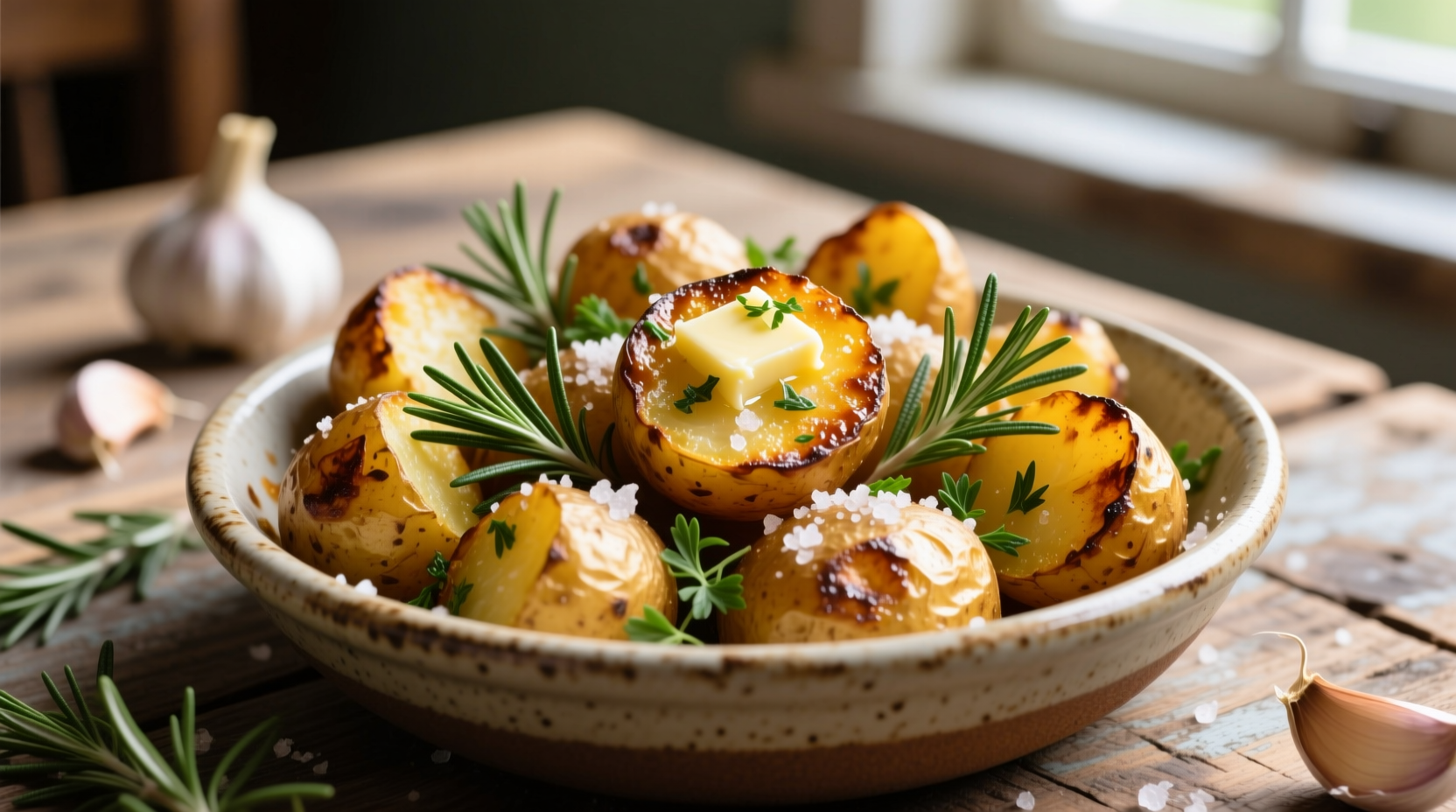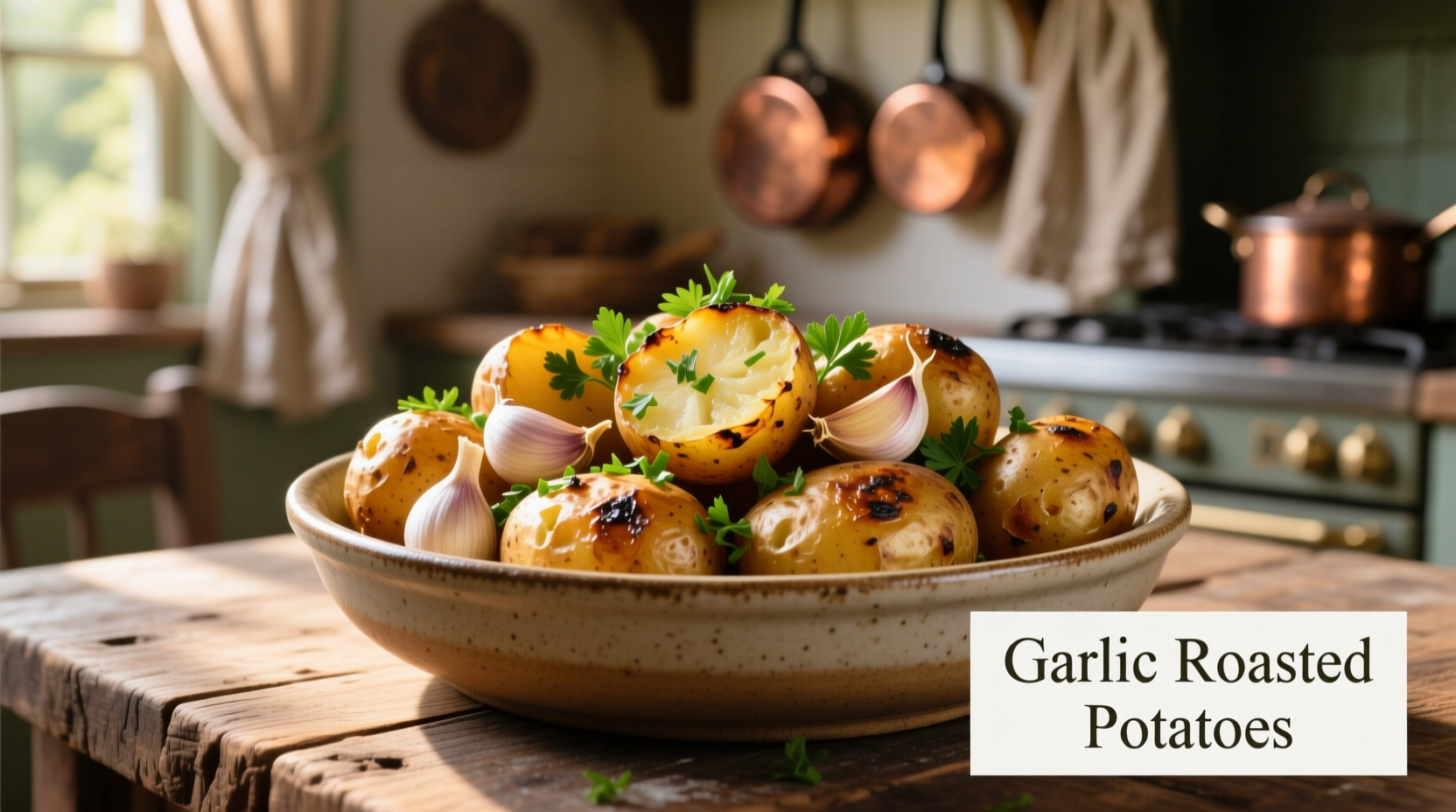The Science Behind Perfectly Crispy Garlic Roasted Potatoes
Garlic roasted potatoes seem simple, but achieving that ideal balance of crispy exterior and fluffy interior requires understanding food science principles. When potatoes hit 300°F (149°C), the Maillard reaction begins—creating complex flavors and that desirable golden-brown crust. The starches on the potato surface gelatinize, forming a protective layer that seals in moisture while allowing exterior crispness.
Garlic presents a special challenge—it burns at 375°F (190°C), well below our ideal roasting temperature. This explains why many home cooks end up with bitter, blackened garlic. The solution? Add garlic halfway through cooking, as confirmed by culinary research from the Culinary Institute of America's flavor development studies.
| Potato Variety | Starch Content | Best For Roasting? | Flavor Profile |
|---|---|---|---|
| Yukon Gold | Medium | ★★★★☆ | Buttery, rich |
| Russet | High | ★★★★★ | Earthy, fluffy |
| Red Bliss | Low | ★★☆☆☆ | Mild, waxy |
| Sweet Potato | Medium | ★★★☆☆ | Sweet, caramelized |
Why Parboiling Makes All the Difference
Professional chefs universally recommend parboiling potatoes before roasting—a technique validated by food science research from USDA Agricultural Research Service. Boiling potatoes in salted water with 1 tablespoon of baking soda for 5-7 minutes roughs up the exterior surfaces. This creates microscopic cracks where oil can penetrate, dramatically improving crispness.
After parboiling, shake the drained potatoes vigorously in the colander. This "fluffing" technique exposes more starch granules, which will caramelize beautifully in the oven. Don't skip this critical step—it's the difference between soggy and spectacular.
Garlic Transformation Timeline: From Raw to Perfectly Roasted
Understanding garlic's chemical evolution during roasting explains our timing recommendations:
- 0-10 minutes: Raw garlic contains allicin (responsible for sharp bite). At 140°F (60°C), enzymes begin breaking this down
- 10-20 minutes: As temperature rises, sulfur compounds transform into milder, sweeter flavors
- 20-30 minutes: At 300°F (149°C), complex caramelization creates nutty, umami-rich compounds
- 30+ minutes: Beyond 375°F (190°C), garlic burns, producing bitter acrylamides
This precise timeline, documented in Journal of Agricultural and Food Chemistry studies, is why we add garlic only during the final 15-20 minutes of roasting.
Step-by-Step Method for Foolproof Results
Follow this professional technique for guaranteed success:
- Preheat oven to 425°F (220°C) with rack in upper third position
- Parboil 2 lbs cubed potatoes (1.5-inch pieces) in salted water with 1 tbsp baking soda for 7 minutes
- Drain thoroughly and shake vigorously in colander for 30 seconds
- Toss potatoes with 3 tbsp high-smoke point oil (avocado or grapeseed)
- Spread in single layer on parchment-lined baking sheet
- Roast 25 minutes until edges begin browning
- Flip potatoes, add 4 minced garlic cloves and 1 tsp rosemary
- Roast additional 15-20 minutes until golden and crisp

Avoiding Common Pitfalls: Expert Troubleshooting
Even experienced cooks encounter these issues. Here's how to fix them:
- Soggy potatoes: Oven temperature too low or overcrowded pan. Use an oven thermometer and ensure single-layer spacing with 1/2 inch between pieces
- Burnt garlic: Added too early. Always incorporate garlic during final third of cooking time
- Uneven browning: Failed to flip halfway. Rotate pan and flip potatoes at 25-minute mark
- Bland flavor: Underseasoned. Potatoes need 1.5% salt by weight (about 1.5 tsp per pound)
Flavor Variations for Every Occasion
Once you've mastered the base technique, experiment with these chef-approved variations:
- Mediterranean style: Add lemon zest and oregano with the garlic
- Smoky paprika: Toss with 1 tsp smoked paprika before roasting
- Herb-infused: Nestle rosemary and thyme sprigs among potatoes
- Crispy parmesan: Sprinkle 1/4 cup grated parmesan during last 5 minutes
For dietary adaptations, swap oil for duck fat (richer flavor) or use avocado oil for vegan versions. Note that sweet potatoes require 10 fewer minutes roasting time due to higher sugar content.
Serving Suggestions and Perfect Pairings
These versatile potatoes complement numerous dishes:
- Classic pairing: Serve alongside roasted chicken or steak
- Brunch option: Top with fried eggs and chives
- Cold weather comfort: Pair with braised short ribs
- Lighter meal: Serve with grilled salmon and asparagus
Leftover potatoes transform beautifully—dice small and pan-fry for crispy breakfast hash, or puree with broth for instant potato soup. Avoid refrigerating whole potatoes as they develop off-flavors; instead, store cut portions in airtight containers for up to 3 days.











 浙公网安备
33010002000092号
浙公网安备
33010002000092号 浙B2-20120091-4
浙B2-20120091-4